Name : Mrinal Kanti Bandhopadhyay
District & State : Kolkata, West Bengal
Category : Engineering
Award : Consolation
Award Function : 2nd National Grassroots Innovation Awards
Award Year : 2002
Innovation Description
 Shri Mrinal Kanti Bandopadhyay (55 years), did his graduation with honors in Physics from Calcutta University in 1970. Since childhood, he was very keen in doing experiments to develop things for the benefit of the society. As a student, he participated in several science exhibitions. After entering into Government service in Land Reforms Department, he devised a new method and instrument for preparation of maps. Later, after joining the administrative department, he took up the idea of building a pollution free motorcycle in his free time. Although, the idea of such a motorcycle struck him more than 25 years ago, it could not be fructified due to lack of workshop facilities and funds. He is also thinking about the idea of constructing a new type of eye testing instrument.
Shri Mrinal Kanti Bandopadhyay (55 years), did his graduation with honors in Physics from Calcutta University in 1970. Since childhood, he was very keen in doing experiments to develop things for the benefit of the society. As a student, he participated in several science exhibitions. After entering into Government service in Land Reforms Department, he devised a new method and instrument for preparation of maps. Later, after joining the administrative department, he took up the idea of building a pollution free motorcycle in his free time. Although, the idea of such a motorcycle struck him more than 25 years ago, it could not be fructified due to lack of workshop facilities and funds. He is also thinking about the idea of constructing a new type of eye testing instrument.
Given the high pollution levels in cities, the need for battery-powered vehicles has been felt worldwide. Several models have been developed abroad, but there isn’t a tried and trusted model available in the country.
His focus has been on improving the efficiency of the conventional system and reducing the wastage of motive power. The front of the motorbike has been redesigned to overcome air resistance effectively. The chain sprockets have been sized according to the diameter of the rear wheel, the motor speed and torque developed, in order to obtain minimum current consumption under normal load conditions. The front wheel size has been increased so as to encounter less obstruction while riding on rough roads.
The motor bike uses two 12 volt, 75 ampere-hour lead acid batteries. One aerodynamic fiber sheet is fitted onto the handle bar of the motor cycle, which decreases the battery consumption when speed increases beyond 25 km/h.
The bike achieves a maximum speed of 40 km per hour on normally encountered road conditions. Maximum continuous journey recorded is 120 km at an average speed of 30 km/hr and 150 km at an average speed of 25 km/hr. Velocity and at-a-stretch journey capacity of the motor cycle will vary according to the quality of the batteries used.
In addition to the normal control functions of the motorcycle, he has attached a display to indicate the status of battery consumption. This will enable the rider to decide when to recharge the batteries or how far to go.
The innovator believes that performance of this motorcycle can further be improved to a large extent by some modifications. It will however require some components to be manufactured specifically for the purpose.
http://nif.org.in/innovation/Battery_operated_pollution_free_-Motor_Cycle/170
